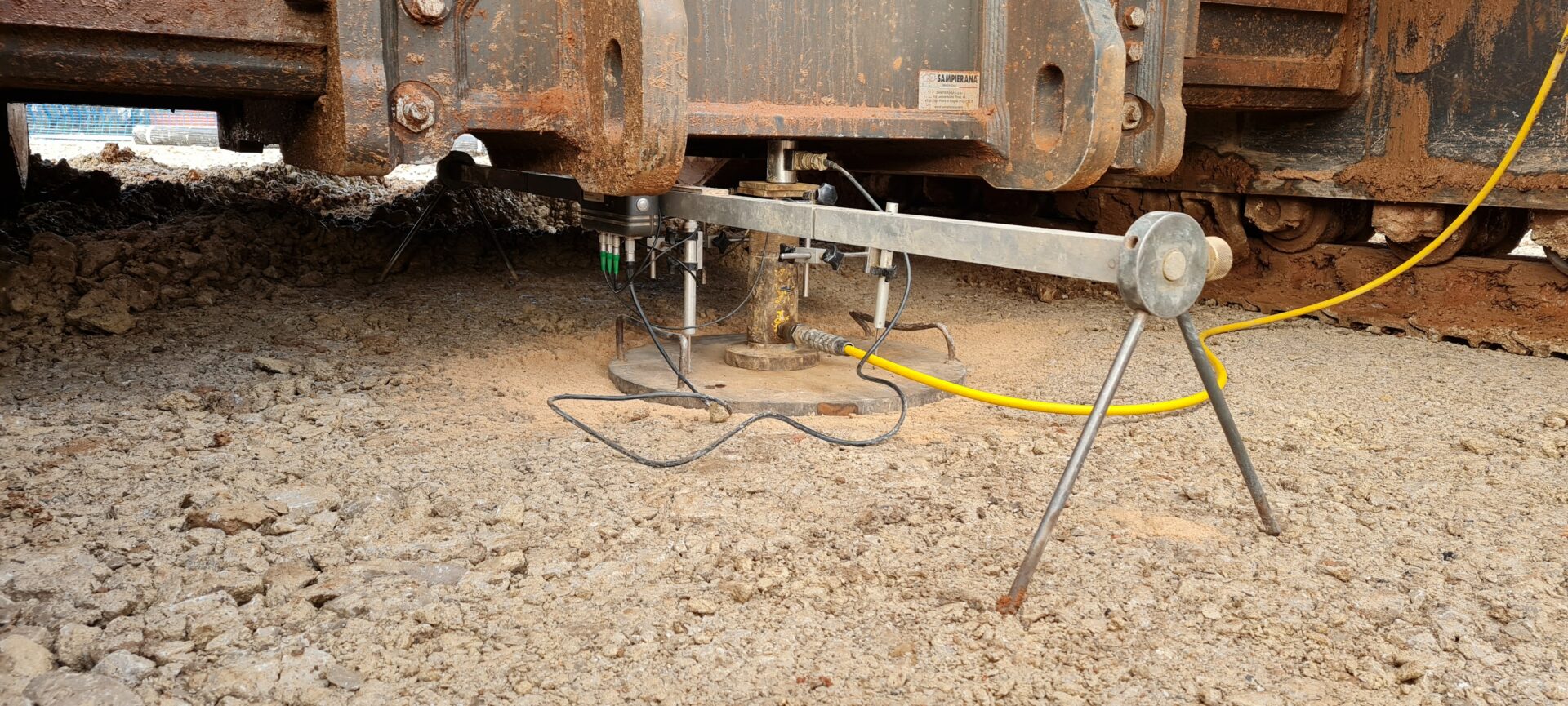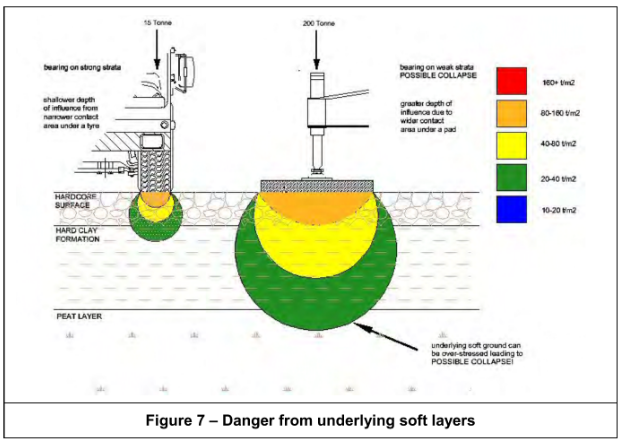Geotechnical Site Investigation (GSI) plays a crucial role in delivering safe and effective temporary works design schemes.
Obtaining accurate and detailed geotechnical information about the ground, allows designers to optimise their designs and minimise the risk of unexpected issues during construction.
When Geotechnical Site Investigation Is Necessary
From basic prop bases to foundation design of large facade retention systems, geotechnical investigations are essential for a wide range of temporary works that interface with the ground. Accurate knowledge of the ground conditions is vital to ensure these designs perform as intended.
| Temporary Works Type | Typical Ground Investigation Requirements |
| Sheet piles | Soil conditions, groundwater levels, impact on neighbouring structures, services |
| Soldier piles and lagging walls | Soil conditions, structural capacity required for the design, services |
| Trench boxes and shoring | Soil type, depth of excavation, groundwater levels, services |
| Scaffolding | Ground conditions, nearby structures, potential hazards, services |
| Temporary bridges | Ground conditions, loading requirements, potential environmental impacts, services |
| Tower cranes and crane bases | Ground bearing capacity, potential obstructions, constraints for crane operation, nearby slopes/batters |
| Temporary propping and falsework foundations | Ground conditions, load requirements, potential impacts on adjacent structures, services |
| Piling mats | Ground conditions, bearing capacity, potential obstructions or hazards |
| Ground improvement techniques | Soil conditions, selection of the most appropriate technique |
| Dewatering systems | Groundwater levels, soil conditions, potential environmental impacts |
| Cut & Carve Demolition | Schemes, where buildings are partially demolished and reconstructed require knowledge of the ground conditions to properly design support systems, such as propping, for the remaining structure. |
Types of Geotechnical Investigations
There are several types of geotechnical investigation, each with its own advantages and limitations. The below list shows examples of types of investigations from the most simple to the more in-depth.
Photos and verbal descriptions: While these can provide a rough idea of the ground conditions, they offer limited information for design purposes, and the designers will make conservative assumptions that will lead to an inefficient design.
Historical information: British Geological Survey borehole logs or similar non site specific logs – These logs can give an idea of the general ground conditions in the area but may be outdated or of limited quality. They serve as a useful starting point but should be supplemented with more up-to-date data.
Descriptive borehole logs – These site specific logs provide a more detailed account of the ground conditions, identifying whether the soil is granular or cohesive, its composition and sometimes strength. However, without additional testing, designers will still need to make conservative assumptions based on the descriptions provided.
On-site testing: Standard Penetration Tests (SPT), hand shear vane tests, plate bearing tests, and California Bearing Ratio (CBR) tests – These tests can provide more specific information about the soil’s properties, enabling more accurate design calculations and a more efficient design. However, these tests may have limitations depending on the type of test and the soil conditions.
Laboratory testing and geotechnical reports provide the most accurate and detailed information about the ground conditions. By conducting laboratory tests and analysing the results in a geotechnical report, designers can make more informed decisions and optimise their designs accordingly.
There are several types of geotechnical investigation, each with its own advantages and limitations. The below list shows examples of types of investigations from the most simple to the more in-depth.
Note: The extent of an investigation is commensurate with the complexity of the design. Low-risk designs may only warrant a photo and verbal description however foundation design for a large temporary bridge will require more.
A brief note on the limitations of Plate Bearing Tests
Plate bearing tests have their limitations, particularly when it comes to justifying crane positions. While they can confirm the proper compaction of a working platform, the designer will need more information about the deeper ground layers supporting the crane.
It is essential to conduct additional site investigations to identify and account for any potential soft layers beneath the working platform.
The figure below from SFPSG Guidance on Ground Conditions for Construction Plant shows the potential pitfall from misunderstanding load vs pressure and their relationship with the business pressure bulbs.
Ref SFPSG Guidance on Ground Conditions for Construction plant.
Important Aspects of Geotechnical Site Investigation
The following aspects should be considered during geotechnical investigations:
Internal angle of friction: This property is crucial when dealing with granular soils, as it directly impacts the soil’s strength. Designers can use descriptions and SPT values to estimate the internal angle of friction, but laboratory testing is preferred for more accurate results.
Undrained shear strength: For cohesive soils, undrained shear strength is an important parameter in temporary works design. Estimations can be made using SPT tests, CBR tests, or correlations, but again, laboratory testing or hand shear vane testing are the most reliable method.
Unit weight and water table: Knowledge of the soil’s unit weight and the water table location is essential for designs involving retaining walls, buried structures, and granular soils. In the latter case, the water table can significantly impact the strength of granular materials.
Stiffness: For deflection-critical structures like tower cranes or façade retention schemes, the stiffness of the underlying ground is vital. Although relationships between ground stiffness and other parameters exist, laboratory testing remains the most accurate method for determining this property.
The Impact of Ground Conditions on Design Efficiency of crane mats
Changing ground conditions can lead to substantial differences in the design of temporary works, such as crane mats or working platforms.
Accurate geotechnical information allows designers to optimise these designs, potentially reducing the required thickness of the mat and saving resources. Conversely, conservative assumptions based on limited or poor-quality data can result in overdesign and increased costs.
Example: 50 tonne outrigger on a timber mat on a granular subgrade. With very poor GI a designer may be forced into taking a very loose soil for the design.
However, should the soil be medium dense, then there is a 50% saving on material alone without factoring in construction cost and muck away savings. See below tabulated examples of typical granular mat thicknesses required for the different ground conditions.
| Internal Angle of Friction (deg) | Granular mat thickness |
| 28 (very loose) | 0.4m |
| 30 (loose) | 0.35m |
| 33 (medium dense) | 0.2m |
| 36 (dense) | 0.1m |
When the available information is limited or uncertain, designers will err on the side of caution and create more conservative designs, which can lead to increased costs and less efficient construction processes.
The Value of Geotechnical Site Investigation
In summary, geotechnical investigation plays a vital role in the success of an efficient temporary works design.
Accurate, detailed, and reliable information about the ground conditions allows designers to optimise their plans, ensuring safety, efficiency, and cost-effectiveness.
Investing in thorough geotechnical investigation upfront that is proportional to the risk can lead to significant savings and improved project outcomes.


